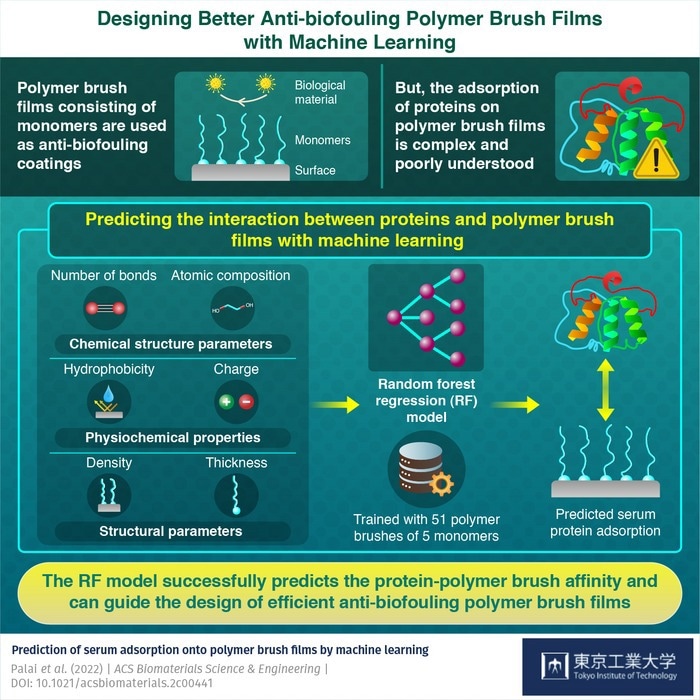Polymer brush films consist of monomer chains that are grown in close proximity on a substrate. The monomers, which at the nanoscale resemble “bristles,” create a very useful and adaptable covering that can specifically adsorb or repel a range of chemical or biological compounds.

Image Credit: Tokyo Tech
For example, polymer brush films have been used as defensive anti-biofouling coatings to ward off undesired biological organisms, as well as a scaffold to develop biological cells.
Polymer brushes have been created as anti-biofouling coatings principally based on the relationship between monomers and water molecules. However, due to the intricate interactions required, quantitative prediction of the adsorption of biomolecules, like proteins, onto monomers has proven difficult despite the simplicity of the design.
Now, a research team from the Tokyo Institute of Technology (Tokyo Tech), Japan, has used machine learning to anticipate these interactions and discover the film properties that significantly affect protein adsorption in a new work published in ACS Biomaterials Science & Engineering.
To train the machine-learning algorithm, the team created 51 different polymer brush films with varying densities and thicknesses for their study. They then put a number of these algorithms to the test to see how closely their forecasts matched the actual protein adsorption measurements.
We tested several supervised regression algorithms, namely gradient boosting regression, support vector regression, linear regression, and random forest regression, to select the most reliable and suitable model in terms of the prediction accuracy.
Dr. Hayashi, Tokyo Institute of Technology
The model that had the highest agreement with the measured protein adsorption values among these was the random forest (RF) regression model. To determine how the polymer brush’s physical and chemical characteristics connect to its capacity to bind serum protein and promote cell adhesion, researchers employed the RF model.
“Our analyses showed that the hydrophobicity index, or the relative hydrophobicity, was the most critical parameter. Next in line were the thickness and density of polymer brush films, the number of C-H bonds, the net charge on the monomer, and the density of the films. Monomer molecular weight and the number of O-H bonds, on the other hand, were ranked low in importance,” explains Dr. Hayashi.
Adopting machine learning to optimize polymer brush film properties can be a good place to start when creating effective anti-biofouling materials and useful biomaterials because of the highly variable nature of polymer brush films and the numerous variables that affect the interactions between monomers and proteins.
Journal Reference
Palai, D., et al. (2022) Prediction of Serum Adsorption onto Polymer Brush Films by Machine Learning. ACS Biomaterials Science & Engineering. doi.org/10.1021/acsbiomaterials.2c00441.